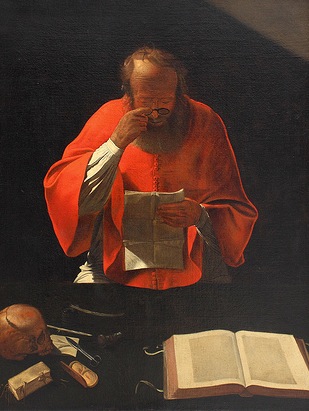Silent Reading
.jpg) Johannes Vermeer, "Girl Reading a Letter at an Open Window" (1657), oil on canvas
Johannes Vermeer, "Girl Reading a Letter at an Open Window" (1657), oil on canvas
[Staatliche Kunstsammlungen, Gemäldegalerie, Dresden]
Between the sixteenth and eighteenth centuries, as growing numbers of people learned to read, new ways of reading became popular. The most novel of these, as Philippe Aries has noted, was private reading in a quiet place away from other people, which allowed the reader to engage in solitary reflection on what he or she read. This ‘privatization’ of reading is undeniably one of the major cultural developments of the early modern era.
What conditions made it possible? First of all, people needed to acquire a new skill: the ability to read without pronouncing the words as they were read. Otherwise the reader remained subject to communal constraints while reading in a library, say, or a room where others were present. Silent reading also made possible the immediate internalization of what the reader read. Reading aloud was slow, laborious, and externalized; silent reading was faster, easier, and more immediate in its impact on the inner self. Apparently, during the Middle Ages, one group of readers after another mastered the technique of silent reading. The first were the copyists working in the monastic scriptoria. Then, around the middle of the twelfth century, scholars in the universities acquired the ability. Two centuries later the lay aristocracy learned to read silently. By the fifteenth century silent reading was the norm, at least for readers who also knew how to write and who belonged to segments of society that had long been literate. For others, who belonged to groups that slowly learned to read and for whom books remained strange, rare objects, the old way of reading no doubt remained a necessity. As late as the nineteenth century, neophytes and maladroit readers could be identified by their inability to read silently. In Labiche’s play La Cagnotte (1864), the farmer Colladan replies to a person who loses patience when he reads a very private letter out loud: ‘If I read out loud, it’s not for you, it’s for me... Whenever I don’t read out loud... I don’t understand what I’m reading.’ Silent reading opened new horizons for those who mastered it. It radically transformed intellectual work, which in essence became an intimate activity, a personal confrontation with an ever-growing number of texts, a question of memorization and cross-referencing. It made possible a more personal form of piety, a more private devotion, a relation with the sacred not subject to the discipline and mediation of the Church. The spirituality of the mendicant orders, the devotio moderna, and even Protestantism, all of which presuppose a direct relation between the individual and God, relied heavily on silent reading, which enabled at least some people to nurture their faith on private reading of spiritual books or the Bible itself. Finally, silent, secret, private reading paved the way for previously unthinkable audacities. In the late Middle Ages, even before the invention of the printing press, heretical texts circulated in manuscript form, critical ideas were expressed, and erotic books, suitably illuminated, enjoyed considerable success.
Although the invention of printing was indeed a ‘revolution’ in that it made it possible to produce a large number of identical copies at a cost much lower than that of copying by hand (even at a time when print runs were small and printing costs quite high), it should not be credited with intellectual and psychological changes that were really the result of a new method of reading, regardless of whether the text was printed or manuscript. By the sixteenth century, the ‘other revolution’ — the revolution in reading — was already accomplished, although it had only recently made its impact felt on laymen and remained incomplete, since large numbers of readers who had not yet mastered writing were incapable of reading silently. There seems to have been a clear division between those for whom reading was a private act and those for whom it remained a communal act, perhaps even an act of class solidarity.
[Excerpt from Roger Chartier, “The Practical Impact of Writing” in History of Private Life, vol. 3: Passions of the Renaissance (Harvard University Press, 1993)]
